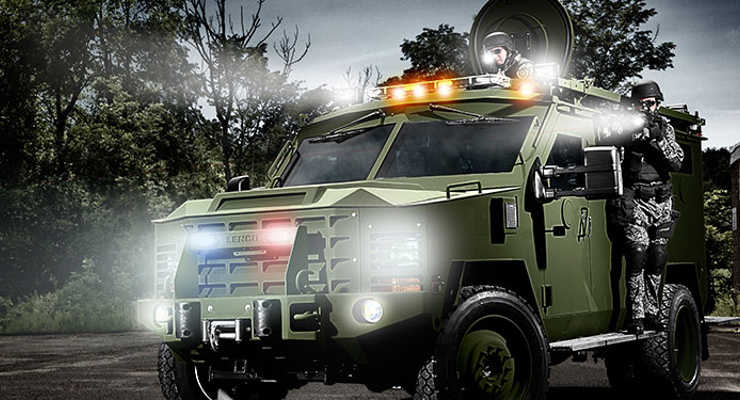

Some SWAT teams use armored vehicles like this Lenco BEARCAT.
SWAT Teams in America
The use of Special Weapons & Tactics (SWAT) teams by police departments across the country started over 50 years. In fact, several departments had specialized teams to bust up Prohibition Era rackets, making specialized police “tactics” units nearly 100 years old.
However, recently the use of heavily armed and fatigue-clad police officers has come under increased scrutiny and question by the media, anti-police groups, and many of our citizens. This level of attention has caused some police commanders to respond with knee-jerk reactions, restricting the use of SWAT teams when their use is not only appropriate but necessary as well. So the discussion on the use of tactical teams is very important.
I’ve been in the Special Operations arena for over 13 years, and I’m an avid supporter of the use of SWAT Teams – in appropriate situations. However, my primary assignment has predominately been in field operations, so I feel I have a better ability to step back and examine this debate with an open mind from the law enforcement perspective.
The pundits that call for a complete elimination of police SWAT Teams, and the heavy personal armor and armored vehicles that often comes with these units, are blinded by a misunderstanding of the real needs and uses of SWAT Teams. However, I think there needs to be a real evaluation of just when it is, in fact, appropriate to use SWAT Teams.
The Patrol Mission
The patrol officer is trained, equipped, and given the mission to investigate criminal activity, apprehend criminal offenders, patrol areas of responsibility as a crime reduction and detection method, and respond to public safety situations. Patrol officers follow the Peel method of wearing clearly identifying uniforms, badges, and patrol duty gear. These items are perfect to complete the primary missions of patrol mentioned before.
However, for years, when a critical incident did develop, patrol officers were not equipped to handle the situation. The mission of patrol then became to secure and contain the scene and call in specialized units to solve the problem. This worked in many isolated incidents, however, as incidents of active shooters, terrorist activity, and other high importance critical incidents began to become more prevalent across the country the patrol mission changed.
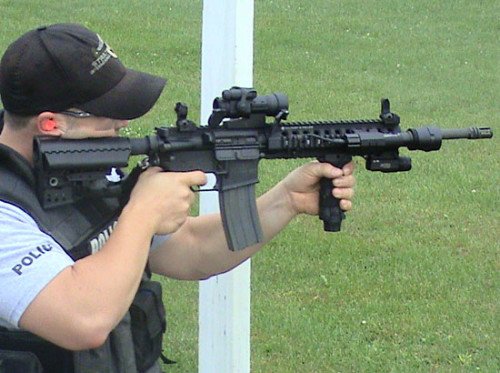
A patrol rifle with optics and weapon mounted light.
Many departments realized that the patrol officer would have to change tactics and missions in order to answer highly dynamic critical events, particularly when innocents are being actively killed or wounded. To this end, many departments began training patrol officers in Response to Active Shooters, and equipping trained patrol officers with patrol rifles. The most prevalent patrol rifle in American law enforcement is the AR-15 rifle.
There are several reasons that the AR-15 rifle has become the most popular law enforcement patrol rifle:
The use of a patrol rifle is not a new concept. In the Old West a lawman didn’t go out without a Winchester or Henry rifle or shotgun, to supplement his sidearm. When America entered the start of organized crime during Prohibition, the rise of violence led many American police agencies to arm their officers with Thompson sub-machine guns, and Browning BAR’s to counter and defeat some of America’s most infamous criminals.
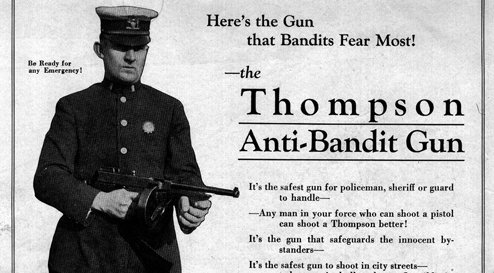
The Thompson sub-machine gun was a powerful tool to combat the start of Organized Crime (a Thompson advertisement).
Even with advanced training and armament, to think that some of the most heavily armed and organized criminals can be effectively handled through simple Patrol tactics and personnel is fundamentally flawed. The real threat of organized crime, drug trafficking organizations, violent felons, and terrorists requires highly trained and heavily equipped police forces.
Police departments are still charged with responding to active shooters, and lone wolf attacks, and active gang violence, armed robberies, and more. These types of threats present serious threats to the community and to the officers who respond to stop them. In some situations, it is just not safe to use patrol officers to perform tasks that require highly trained personnel using highly technical tactics and equipment. That is what SWAT teams are designed and trained for.
The SWAT Mission
SWAT – Specialized Weapons And Tactics. The name describes the means to accomplish the mission, but it doesn’t say it all. The basic mission of the SWAT Team is to save lives and apprehend the most violent criminal offenders facing law enforcement and society. Even when SWAT is going up against the most violent predators of society, the ultimate mission is to successfully outmaneuver the criminals and get them to surrender peacefully to face their day in court.
Not all SWAT Teams are created equal. The National Incident Management System (NIMS) classifies teams by the number of personnel, specialized equipment possessed, and high-risk missions a team is capable of performing. Only a very few teams reach the Level I status, that are teams capable of responding to all types of missions, from airborne missions, to water-deployed, to explosive entries and WMD scenes.
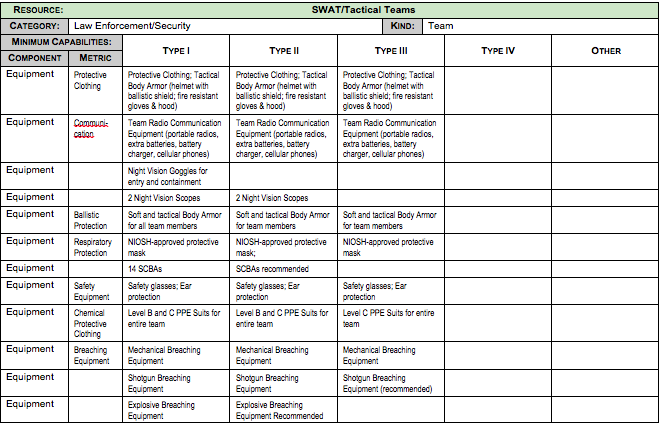
The NIMS system classifies SWAT teams by their abilities and equipment.
The majority of SWAT Teams are at Level II or Level III. These teams are typically capable of responding to armed barricaded subjects, hostage taker incidents, active shooters, and serving high risk search warrants. They are not prepared for hazardous materials situations like meth lab entries or WMD scenes, and do not have the appropriate night vision, SCBA, and additional equipment necessary for the worst case scenarios that require a Level I team.
Many departments have shied away from the SWAT title, because of the “weapons” portion of the name. Instead they use a variety of monikers, such as:
Whatever a department calls their team, the primary mission of the specialized tactical team is to save lives and apprehend serious offenders.
MISSIONS DESIGNED FOR SWAT
With the debate on “militarized” police raging in the media and anti-police propaganda, I think it is important to discuss the missions that require SWAT, the missions that SWAT should be considered, and the missions that may not need SWAT at all.
TYPICALLY ASSIGNED SWAT MISSIONS:
HOSTAGE TAKER
These situations are the second most serious calls that a police department could face, only below an active shooter/terrorist event where innocent civilians are being killed or injured continually. In a hostage taker situation, standard patrol officers are not equipped to properly deal with the threat to people being held hostage.
To properly engage these threats police need to deploy especially trained negotiators, along with expert marksmen with scoped rifles. Both of those positions require extensive training and expertise to be successful, and are far outside the purview of standard patrol officers.
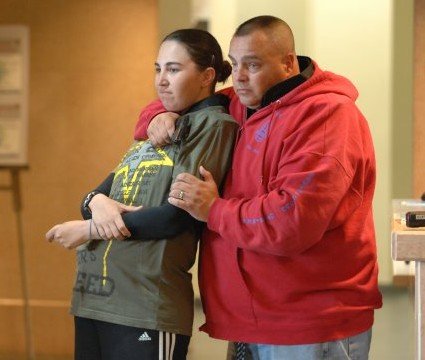
A hostage taker requires the most skilled and trained officers to successfully counter. (photo by army.mil)
Finally, the officers who may have to make an emergency entry to rescue the hostages must be masters of breaching, distractionary devices, team movements, and expert rifle and pistol marksmanship. Again, these are not standard skills of patrol officers, and if left to patrol will likely have tragic results.
ACTIVE SHOOTER/TERRORIST ACTIONS
Without a doubt, patrol officers will be the first to respond and act on an active shooter/terrorist action except, perhaps, if the incident breaks off on a high profile location or event like a sports game, conference, or dignitary visit. Some SWAT operators are on the streets in a full-time capacity and may be first responders. Others who are on part-time teams may also be in patrol and first on scene. Even still, departments with SWAT Teams are very likely to deploy their specialized skills and equipment as a part of the overall mission.
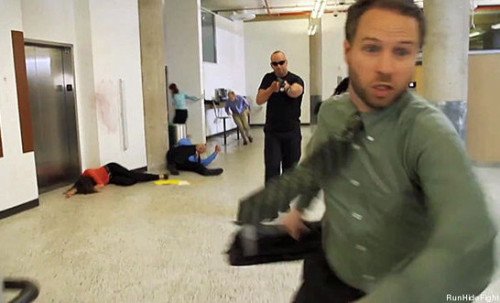
A still shot of the Homeland Security video on active shooters – Run, Hide, Fight (photo from U.S. Homeland Security)
Even with patrol’s initial response, there are situations where a SWAT Team may be pivotal in ending the threat successfully. If the active shooter/terrorist has barricaded themselves in a SWAT team has the tools and training to defeat that. If the active shooter/terrorist is cornered inside a structure with innocents, then a SWAT team can work for a resolution under the HOSTAGE TAKER guidelines.
Not often mentioned in the overall “life saving” mission, these missions do exist and often fall on SWAT. When high potential target dignitaries come to your jurisdiction, it is the SWAT team that is called to supplement the dignitaries own protection detail. SWAT has armored vehicles, heavy ballistic gear, team training, equipment, snipers and a command structure designed to operate in high stress, dynamic situations.
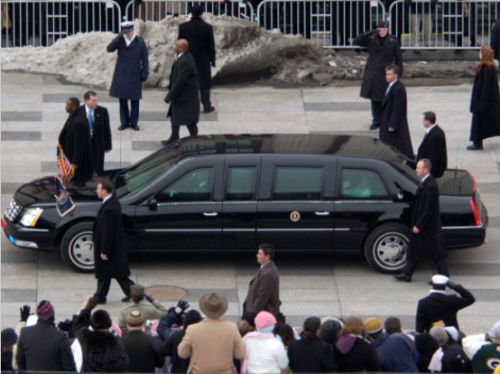
The trench coats are obvious, but there is a SWAT team nearby watching, ready. (photo by US Secret Service)
In 2 of the last 3 Presidential elections my team was called upon to provide dignitary protection for the President, Vice President, and Presidential hopefuls. Though the U.S. Secret Service was the primary protective detail close to these dignitaries, our SWAT team provided significant assistance on the periphery of the event location. Everything from sniper overwatch to ingress/egress control, our team was a pivotal component in the overall mission. This is not unusual.
SEARCH & ARREST WARRANTS
I believe this is one of the most controversial areas of uses for SWAT teams. Originally, SWAT teams were called upon to conduct only the most high-risk search and arrest warrants. However, the original teams that were organized (LAPD, Philadelphia, NYPD, Chicago) were in some of the most violent cities in the country, so their use was frequent and targeted those very violent offenders.
Remember, when SWAT was developed in the 1960’s America was facing some of the most violent times in history. The Civil Rights Movement, the explosion of illegal drugs, Anti-establisment revolutionary groups, Vietnam War protests, the growth of outlaw motorcycle gangs, and criminal gangs. America was experiencing serious growth pains. As more cities, and counties developed SWAT teams to respond to dangerous situations outside of traditional patrol functions, the function of the SWAT team began to expand.
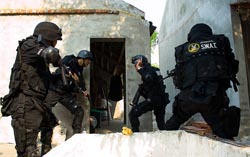
A tactical team preparing to make entry into a structure.
(Photo courtesy of Trung Nguyen)
In no other area besides Search and Arrest Warrant services has the SWAT mission seen so many changes. Unfortunately, many departments began to use their full SWAT teams even for minor warrants for misdemeanor drug offenses or property crimes. The criteria to use the SWAT team simply became any time there was a search or arrest warrant. If a threat assessment was completed it was only a cursory evaluation and part of the briefing, not a guide to the use of the team.
SWAT became the answer. What used to be done by detectives became the roll of SWAT, and for good reason. Too many officers wearing jeans a jacket with “police” on it were making risky entries into the “castle” of a target, and were being killed or injured due to lack of proper weapons, tools, body armor and training.
In one famous picture, a Border Patrol SWAT team entered a residence in Miami, Florida to take custody of Elian Gonzalez, who had entered the United States illegally from Cuba, with his mother and her boyfriend. Elian’s mother drowned in the journey, and Federal Courts ruled Elian had to be returned to Cuba.
The image of a heavily armed Federal Agent bursting into a room to take Elian captured the essence of the battle over the use of SWAT teams. Before anyone goes too far to against the Border Patrol SWAT in this incident, we should remember that the family had advertised their intent to resist. INS had identified around 20 people who would likely be present, some with concealed weapons, and several with criminal records. When the agents arrived to execute the court order, family and friends tried to block the agents, even throwing bottles, rocks and a stool at them.
Still, the image of a young boy being forcibly taken by heavily armed Federal agents did not sit well with most Americans. And, I agree. The use of a SWAT team should only be considered when a set of particular and strict criteria are met. American law enforcement agencies need to reconsider the use of SWAT teams as a standard practice.

NTOA is the premier tactical officers association.
The National Tactical Officer’s Association (NTOA) has been acknowledging that a SWAT team is not necessary for all actions. Low profile and low threat targets typically do not justify the use of a heavily armed and outfitted team. So how does a department and its commanders decide when a SWAT team is appropriate.
Here are a few criteria that could justify a SWAT team in anyone’s mind:
THREAT ASSESSMENTS AND INTELLIGENCE
Each of these criteria alone may not warrant a full-team call-out, however a point system should be established and weighted to ensure the officers are safe, and the justification exists to call out SWAT. This is the heart of threat assessment. These points are determined from diligent intelligence gathering before the service is even planned.
This intelligence should be started by the detectives and/or patrol officers, but should not stop there. SWAT team leaders have a duty to their team and the department to vet the intelligence and then get their own intelligence. Pre-raid planning should involve conducting independent criminal history checks (I have found big warning indicators missed by a lazy detective), and should also involve a covert drive-by of the location to investigate surveillance, barricades, hardened targets, and any threats from neighbors.
The final decision must be based upon sound intelligence, documented in a threat assessment, and approved by the Commanders in charge of the operation. These steps go a long way in court to avoiding liability for the team.
If the points add up – call out SWAT. If they’re in the middle, the investigators, SWAT team leaders, and Commander of the operation need to get together and make the best decision based upon what is faced. If the points don’t add up, a full team call-out should not be performed.
Some threats will be an automatic full-team call-out. Known to be armed, known to assault law enforcement, and drug labs should all be served with full SWAT teams based on the inherent risks, even if the overall numbers don’t add up. In the low point situations full-team SWAT team use should be avoided. However, the NTOA also recognizes that even low-threat entries can be very dangerous when untrained and unprepared personnel attempt to perform them.
PARTIAL-TEAM CALL-OUTS (SWEEP TEAMS)
For missions that do not add up to full-team call-outs, the department or commander should not buck the system and still use a full SWAT team. Recently, Federal Courts have
NTOA does not recommend that warrants be served by patrol officers or detectives. Despite the intelligence and threat assessment showing a low threat, making entries into residences or other structures is inherently dangerous. Police are entering the private domains of citizens. Even if it is done legally with a search or arrest warrant, the fundamental belief that a person should be secure in their homes can cause even the low threat suspect to respond very violently or with unpredictable actions.
For this reason, these “low threat” warrants should not be served by untrained and under equipped personnel. The Courts have been clear that officers who take actions outside of their training and experience level can and often are found to be civilly liable for civil rights violations, or personal injuries.
So what should a department or commander do when the threat assessment is too low to call out the SWAT team, but the warrant still needs to be served?
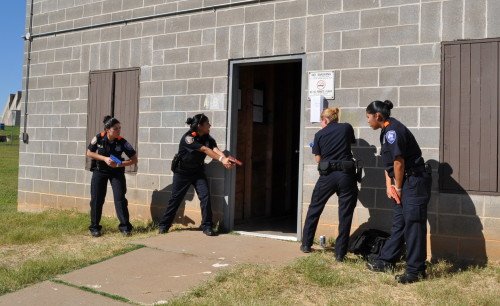
Uniformed SWAT officers making entry as a Sweep Team fulfills legal requirements and safety needs. (photo by sapdexplorers.com)
The NTOA has recognized that even low-threat search/arrest warrants can be dangerous, and has begun to recommend a partial or sweep-team call-out of SWAT personnel. These Sweep Teams are made up of highly trained SWAT officers, but the officers respond in patrol uniforms, and less numbers than a full-team call-out. The use of an armored vehicle would not be justified due to the threat assessment, however, specialized breaching tools and other devices would be justified.
The benefit of the Sweep Team concept is that commanders can feel confident that the best personnel are serving the warrant, and they are following the most current legal doctrine and guidance. Investigators and patrol officers can feel confident that they are not going to be called upon to perform duties and tasks they are not trained or accustomed to. Citizens can feel that their police department is sensitive to their strong desires for freedoms and individual rights, by the absence of heavily armed “militaristic” police officers.
In no way, should a reader believe that a Sweep Team should replace full-team call-outs. Full team SWAT missions, with heavy armor, armored vehicles, distractionary devices, and specialized breaching and entries, are still a very important and viable police mission – when the intelligence and threat assessment justify their use.
This action has gained significant attention due the recent protests in Ferguson, Missouri and Baltimore, Maryland. America has not seen the likes of these types of riots since the O.J. Simpson murder trial. Before that we go all the way back into the 1960’s and the violent riots that ripped across America.
Without doubt the daily marches in Ferguson were by and far peaceful, with the lawful intent of an assembly of citizens protesting and grieving their government. Those marches were joined by police, not just corralled by them, and there was discourse and communication.
However, when the sun fell below the horizon an entirely new group of people arrived, criminal opportunists who saw a way to reek havoc under the cover of a lawful “protest”. These criminals were rarely from the Ferguson area, instead coming in from St. Louis, Chicago, and other destinations for the sole purpose to rain chaos on the community. It was these thugs that looted business, fired weapons into the crowd – at each other – and at the police and media, committed assaults, burned nearly an entire block of local businesses and dozens of vehicles. These were not peaceful people – they were the lowest scum of society – predators.
In these situations the uniformed patrol officers should be out front, portraying the lawful authority given to them by the very community in turmoil. Uniformed presence portrays the law and order that society demands during less trying times, and their presence will stand as the divide between chaos and order. What was almost completely unreported was the fact that the peaceful protestors tried to push the criminals out of their ranks, and even stood by the police who would occasionally move into the crowds to arrest a trouble maker. Things often became so bad that only a few dozen peaceful protestors remained, while hundreds of criminals reeked havoc.
Under these circumstances, a SWAT team has the training, tools, and means to provide a necessary support function to the front line patrol officers. Launching gas projectiles is a specialized skill and requires specially trained personnel – SWAT. In addition, when a rapid team movement needs to be made into a body of hostile people to apprehend a leader of the riot, SWAT teams are more trained to conduct this movement than patrol officers who are mostly trained in crowd control.
The History of LE SWAT Teams
The Los Angeles, CA Police Department made SWAT Teams famous, but they actually were second to the show after Philadelphia, PA Police formed the nation’s first SWAT Team in 1964. Now, after 50 years of SWAT Teams being formally organized in American law enforcement we have seen a movement to seriously hinder or eliminate these teams altogether.
Evaluating Military and Law Enforcement Similarities
There are several training disciplines and pieces of equipment that can legitimately be used by both military and law enforcement personnel. In deed, basic firearms instruction and proficiency drills, often find roots in the military. The National Rifle Association (NRA) was created in 1871 by two Union officers after the Civil War. General Wingate and Colonel Church were dismayed at the accuracy of Union soldiers in battle, and committed themselves to forming an organization to “promote and encourage rifle shooting on a scientific basis.” Firearms instruction remains one of the core values and purposes of the NRA to this day, and they are at still one of the premier law enforcement trainers.
Many defensive tactics techniques taught to police officers are derived from martial (war) arts. The use of tear gas and smoke began in the military decades and millennia before law enforcement, respectively. In fact, early American police uniforms were very similar to military dress uniforms; especially with State Police forces who often selected polished riding boots, bloused and stripped pants, military insignia and rank on shirts, and campaign (Trooper) or officer hats as their uniforms. Almost every American police agency has established a para-military organizational structure as well.
So to be fair, there are a lot of legitimate crossovers between the military and law enforcement. Here are just a few that the majority of Americans understand and accept:
Drawing a Line Between Military and Law Enforcement
However, law enforcement officers must be especially careful and diligent to remain “civilian” in the enforcement of laws and responses to emergencies. Civilian law enforcement remains squarely rooted in Constitutional expectations and limitations, where the military, under martial law, has a much broader exercise of power.
Recognizing these limitations should not cause civilian law enforcement officers pause or consternation. Instead, law enforcement officers should embrace their role in the justice system, and conform to the desires and restrictions placed upon them by their neighbors. That necessarily means that some criminals will work the system and be let free, which is disdainful to all who wear the badge. However, our society (and our oath) firmly lives by the creed, “it is better that 100 criminals go free, than for 1 innocent man to be imprisoned”. This is at the heart of the rights of the people found in the Bill of Rights.
This concept can be profoundly difficult for dedicated law enforcement officers, who develop a great ability to sense right and wrong, and can often smell the wrong from a great distance. Knowing someone is guilty of criminal activity, but being required to let them go due to Constitutional protections, is a difficult pill to swallow. Many officers feel the failure personally, and often project that failure on themselves, rather than appropriately on the system developed with free men in mind. Taking the system’s failure personally is often the root of Constitutional violations later.
The trap is summed up quite nicely by a quote from the movie Top Gun, when Maverick is called on the carpet for breaking the rules to engage and ‘shoot down’ a Top Gun instructor:
Viper: “The hard-deck for this hop was 10,000 feet. You knew it. You broke it … Why?”
Maverick: “Sir, I had him in my sights. He saw me move in for the kill. He proceeded below the hard-deck. We were below for just a few seconds. I had the shot. There was no danger, so I took it.”
Viper: “You took it, and broke a major rule of engagement! … Top Gun rules of engagement exist for your safety and for that of your team. They’re not flexible, nor am I. Obey them or you’re history. Is that clear?”
This exchange can very quickly be turned around in a law enforcement example:
Judge/Commander: “The law on searching a vehicle is clear. You knew it. You broke it … Why?”
Officer: “Sir, I knew he was guilty. He couldn’t answer my questions and gave me all the nervous signs that he was hiding contraband. To hide, he refused to give me consent to search. I searched the car for just a few seconds. I found the illegal drugs I knew would be there. There was no real harm, so I took it.”
Judge/Commander: “You took it, and broke a major Constitutional law on searches! Those Constitutional laws exist to protect you and your family as well from uncontrolled government abuse. They’re not flexible, nor am I. Obey them or you’re history (fired, imprisoned). Is that clear?”
So, for law enforcement of a free people to use military structures, uniforms, equipment, firearms and tactics, they must be particularly able to justify their actions and decisions. No Blue Wall. Agencies need to be forthcoming, honest, and ready to support those decisions with hard data. This doesn’t mean completely exposing every tactic, strength, and weakness; rather, providing an overall clear picture to the elected leaders (and citizens) that the equipment, tools, and tactics are not only necessary, but logically ‘sound and reasonable’. Ever heard that “reasonable” word before? I’ll talk more about that later.